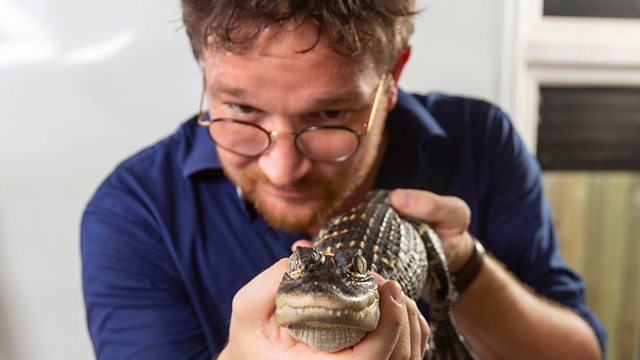Secrets of Skin episode 6 – Sensing: Professor Ben Garrod explores how some snakes can see using heat, how crocodiles feel through their jaws and how some animals use electricity to navigate their world – and it is all only possible because of remarkable adaptations to their skin.
Whether animals live on land, in the sea, or in subterranean communities, skin is critical in allowing them to sense the world around them, be it to find food, navigate harsh environments or avoid danger. Even the toughest of animals, crocodilians, have a surprisingly sensitive side when it comes to the specialised skin sensors they use to detect the tiniest of ripples in the water. Deadly pit vipers use heat sensors to ambush the small rodents they feed on. Professor Ben Garrod puts them to the test with an experiment to see if they will strike a cold or warm ping-pong ball. He also uncovers how the less-than-attractive leaf-nosed bat puts its facial skin to good use as an acoustic lens to echolocate around its dense forest habitat.
Secrets of Skin episode 6 – Sensing
Skin is the layer of usually soft, flexible outer tissue covering the body of a vertebrate animal, with three main functions: protection, regulation, and sensation. Other animal coverings, such as the arthropod exoskeleton, have different developmental origin, structure and chemical composition. The adjective cutaneous means “of the skin” (from Latin cutis ‘skin’). In mammals, the skin is an organ of the integumentary system made up of multiple layers of ectodermal tissue and guards the underlying muscles, bones, ligaments, and internal organs.
Skin of a different nature exists in amphibians, reptiles, and birds. Skin (including cutaneous and subcutaneous tissues) plays crucial roles in formation, structure, and function of extraskeletal apparatus such as horns of bovids (e.g., cattle) and rhinos, cervids’ antlers, giraffids’ ossicones, armadillos’ osteoderm, and os penis/os clitoris.
All mammals have some hair on their skin, even marine mammals like whales, dolphins, and porpoises that appear to be hairless. The skin interfaces with the environment and is the first line of defense from external factors. For example, the skin plays a key role in protecting the body against pathogens and excessive water loss. Its other functions are insulation, temperature regulation, sensation, and the production of vitamin D folates. Severely damaged skin may heal by forming scar tissue. This is sometimes discoloured and depigmented. The thickness of skin also varies from location to location on an organism. In humans, for example, the skin located under the eyes and around the eyelids is the thinnest skin on the body at 0.5 mm thick and is one of the first areas to show signs of aging such as “crows feet” and wrinkles. The skin on the palms and the soles of the feet is the thickest skin on the body as 4 mm thick. The speed and quality of wound healing in skin is promoted by the reception of estrogen.




